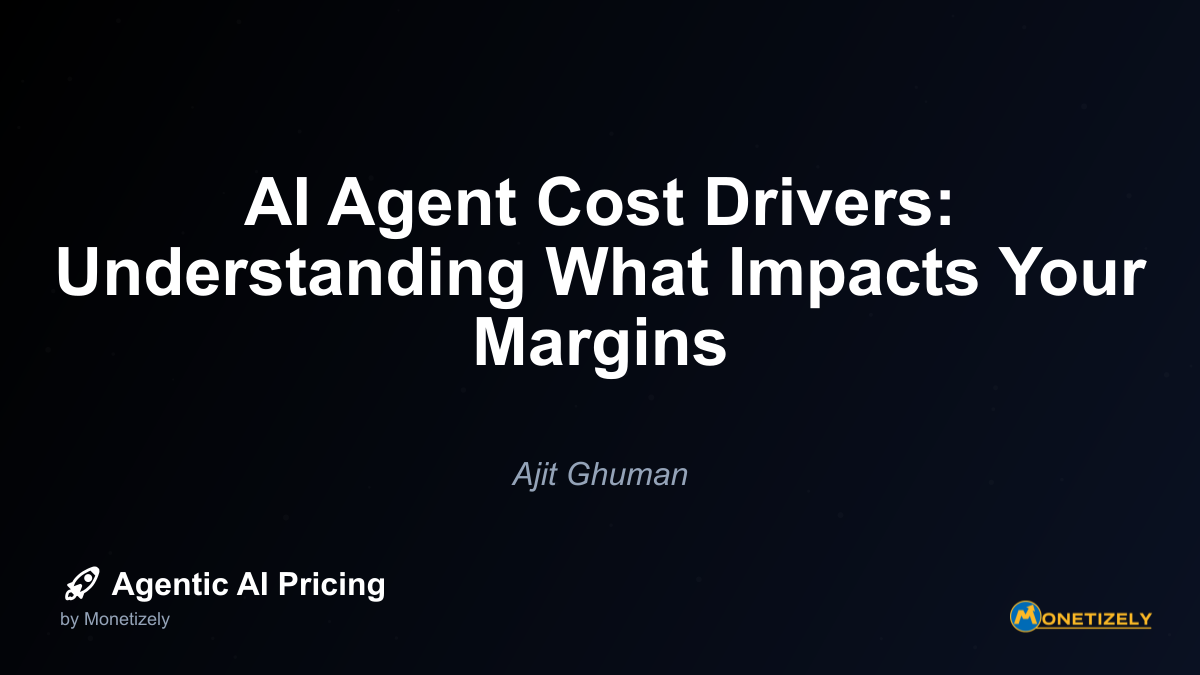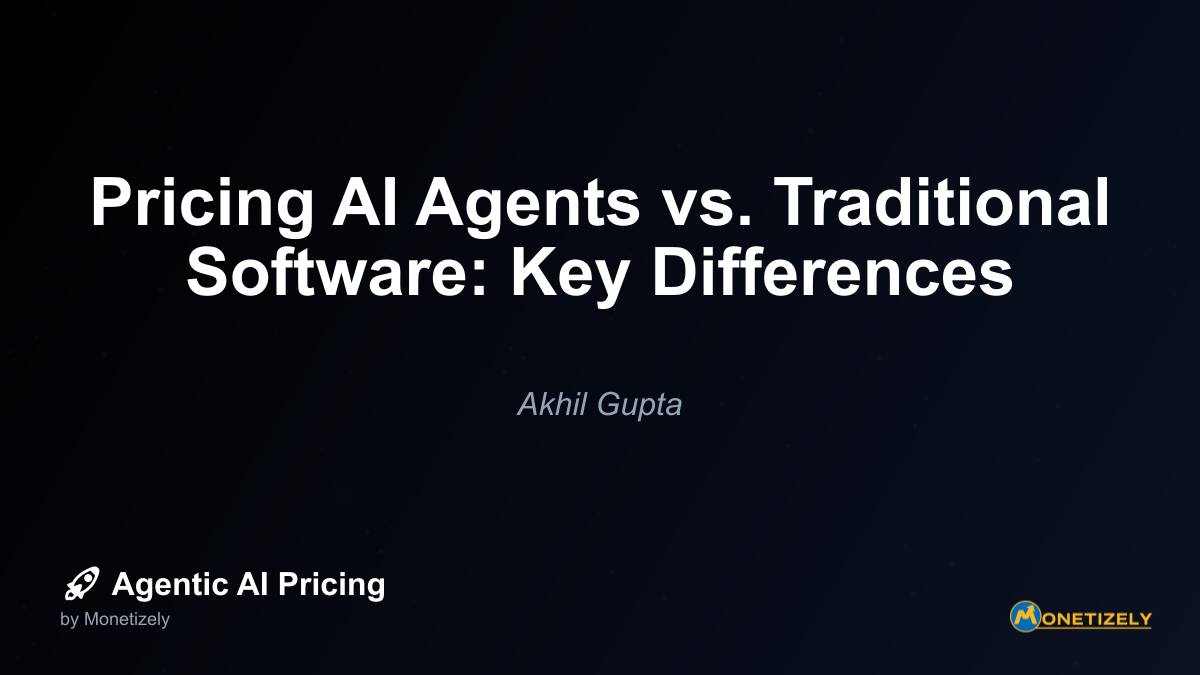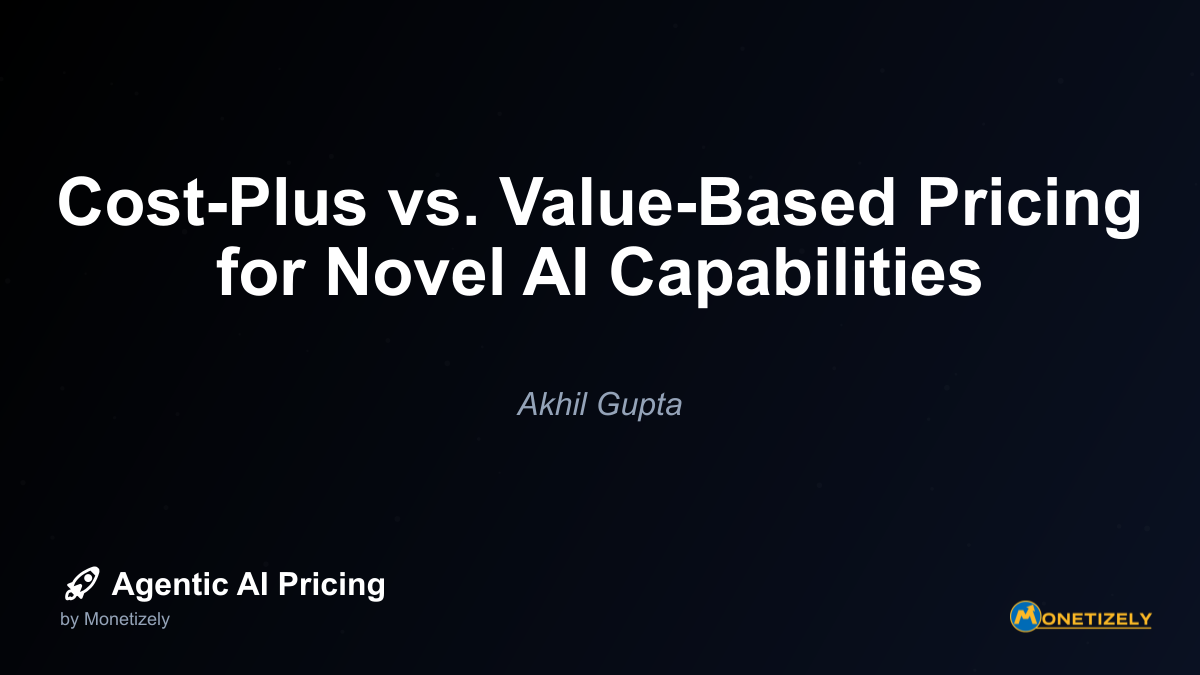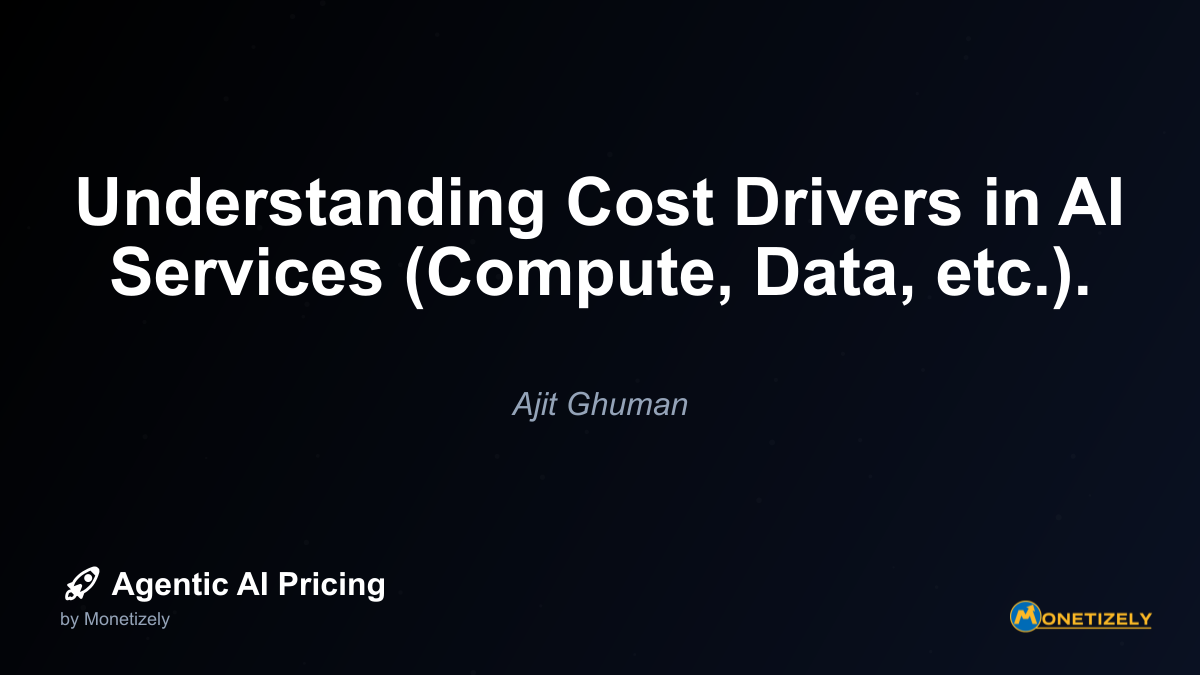· Ajit Ghuman · AI Pricing Fundamentals · 6 min read
AI Agent Cost Drivers: Understanding What Impacts Your Margins
AI and SaaS Pricing Masterclass
Learn the art of strategic pricing directly from industry experts. Our comprehensive course provides frameworks and methodologies for optimizing your pricing strategy in the evolving AI landscape. Earn a professional certification that can be imported directly to your LinkedIn profile.

Talent and Human Capital
Despite automation advances, human expertise remains essential for AI agent success:
Specialized Expertise Requirements AI development demands rare skill combinations:
- Machine learning engineers: Professionals commanding premium salaries ($120,000-$200,000+)
- Data scientists: Specialists in statistical analysis and model development
- Domain experts: Subject matter authorities providing contextual knowledge
- ML operations engineers: Specialists in deploying and maintaining production systems
Knowledge Management and Transfer Preserving institutional knowledge represents a critical cost center:
- Documentation systems: Tools and processes to capture technical decisions
- Training programs: Developing internal expertise to reduce dependency
- Succession planning: Mitigating risks from key personnel departures
Pricing Implications: Translating Costs to Market Models
Understanding how these cost drivers translate into pricing strategies is essential for both providers and consumers of AI agent technologies.
From Cost Structures to Pricing Models
The relationship between costs and pricing requires strategic consideration:
Cost-Plus vs. Value-Based Approaches Fundamental pricing philosophies with different implications:
- Cost-plus pricing: Adding margin percentages to calculated costs
- Value-based pricing: Setting prices based on customer perceived value
- Hybrid models: Combining cost floors with value-driven ceiling prices
Transparent vs. Opaque Pricing Strategies The visibility of cost components affects customer relationships:
- Itemized pricing: Separately charging for distinct cost components
- Bundled pricing: Combining multiple cost elements into single fees
- Tiered structures: Creating service levels with different cost inclusions
Emerging Pricing Models for AI Agents
The AI agent market has developed several distinctive pricing approaches:
Consumption-Based Models Directly tying costs to resource utilization:
- Token-based pricing: Charging based on input/output tokens processed
- Compute-time pricing: Fees calculated on processing time consumed
- API call volume: Charging based on the number of system interactions
- Storage-driven costs: Fees for data retention and management
Outcome-Based Pricing Aligning costs with business results:
- Performance-contingent fees: Prices tied to accuracy or efficiency metrics
- Revenue-sharing models: Costs as a percentage of value generated
- ROI-based pricing: Fees calculated based on demonstrated return
Performance-based pricing models are gaining significant traction in the agentic AI space, particularly for applications where outcomes can be clearly measured and attributed to AI agent actions.
Strategic Cost Management: Optimizing Your AI Agent Economics
With a clear understanding of cost drivers, organizations can implement targeted strategies to optimize their AI agent economics.
Short-Term Optimization Tactics
Immediate actions can yield significant cost improvements:
Resource Utilization Efficiency Maximizing return on existing investments:
- Auto-scaling infrastructure: Dynamically adjusting resources to match demand
- Workload scheduling: Running intensive processes during lower-cost periods
- Caching strategies: Reducing duplicate computations through intelligent storage
- Model compression techniques: Reducing computational requirements without sacrificing quality
Vendor Management and Negotiation Leveraging market competition to reduce costs:
- Multi-vendor strategies: Creating competitive tension among providers
- Volume commitments: Securing discounts through usage guarantees
- Contract optimization: Aligning payment terms with cash flow patterns
- Open-source alternatives: Utilizing non-commercial options where appropriate
Long-Term Strategic Investments
Forward-looking decisions can fundamentally alter cost structures:
Architectural Decisions with Cost Implications Fundamental design choices that affect long-term economics:
- Monolithic vs. microservice architectures: Balancing development and operational costs
- Edge vs. cloud processing: Distributing computation to optimize for latency and bandwidth
- Proprietary vs. open-source foundations: Trading control for community support
- Vertical integration: Owning more of the technology stack to reduce external dependencies
Organizational Capability Development Building internal strengths to reduce external dependencies:
- Technical talent development: Growing specialized expertise internally
- Knowledge management systems: Preserving insights and reducing relearning
- Process automation: Reducing manual intervention in routine activities
- Intellectual property creation: Developing proprietary assets that reduce licensing costs
Industry-Specific Cost Considerations
Different sectors face unique AI agent cost dynamics based on their regulatory environments, data characteristics, and use cases.
Financial Services
The highly regulated financial sector faces distinctive cost pressures:
Regulatory Compliance Premium Financial institutions bear additional costs for:
- Model validation requirements: Rigorous testing mandated by regulators
- Explainability standards: Higher transparency demands than other sectors
- Audit trail infrastructure: Comprehensive record-keeping for regulatory review
- Security certifications: Specialized assessments for financial applications
High-Stakes Decision Support Applications involving significant financial consequences require:
- Enhanced reliability measures: Redundant systems to prevent failures
- Rigorous validation protocols: Extensive testing before deployment
- Human-in-the-loop components: Expert oversight adding operational costs
- Insurance and liability protections: Coverage for potential errors
Healthcare and Life Sciences
Medical applications introduce specialized cost factors:
Clinical Validation Requirements Health applications demand rigorous testing:
- Clinical trials: Formal studies demonstrating efficacy and safety
- Regulatory approvals: FDA and international certification processes
- Patient safety protocols: Systems preventing harmful recommendations
- Medical expert involvement: Specialized clinical knowledge integration
Data Sensitivity and Privacy Health information requires exceptional protection:
- HIPAA compliance infrastructure: Specialized security and privacy measures
- De-identification processes: Systems to protect patient identities
- Consent management: Tools for tracking patient permissions
- Secure data exchange: Protected methods for sharing sensitive information
Pricing specialized AI agents in regulated industries requires careful consideration of these additional cost factors, which can significantly impact sustainable pricing structures.
Future Cost Trajectories: Anticipating Change
The economic landscape for AI agents continues to evolve, with several trends likely to reshape cost structures in coming years.
Technological Inflection Points
Several developments promise to alter fundamental cost equations:
Hardware Evolution Specialized AI processing continues to advance:
- AI-specific chips: Custom silicon designed exclusively for neural networks
- Quantum computing applications: Potential exponential improvements for specific problems
- Neuromorphic computing: Brain-inspired architectures with different efficiency profiles
- Edge computing maturation: More capable local processing reducing cloud dependencies
Algorithmic Efficiency Improvements Software advances driving better resource utilization:
- Model distillation techniques: Creating smaller models with similar capabilities
- Sparse neural networks: Reducing computational needs through structural optimization
- Few-shot learning improvements: Reducing data requirements for training
- Transfer learning advances: Better leveraging of pre-trained components
Market and Ecosystem Evolution
The competitive and collaborative landscape continues to mature:
Commoditization Pressures Standard capabilities becoming more affordable:
- Foundation model accessibility: Increasing availability of powerful pre-trained systems
- API standardization: Simplified integration reducing implementation costs
- Open-source proliferation: Non-commercial alternatives for common functions
- Competitive market maturation: Price pressure from increasing provider options
Specialization and Verticalization Industry-specific solutions creating new value propositions:
- Domain-optimized models: Systems tailored for specific sectors
- Integrated industry solutions: Pre-built applications reducing custom development
- Regulatory-compliant offerings: Pre-certified systems for regulated industries
- Industry data cooperatives: Shared datasets reducing individual acquisition costs
Conclusion: Mastering AI Agent Economics
The cost drivers shaping AI agent economics represent a complex but navigable landscape for forward-thinking organizations. By developing a sophisticated understanding of these factors, business leaders can make more informed decisions about AI agent investments, pricing strategies, and competitive positioning.
Successful organizations will adopt a multifaceted approach to AI agent economics:
- Holistic cost visibility: Maintaining comprehensive awareness of all cost components
- Scenario planning: Developing flexible strategies for different cost evolution paths
- Strategic cost management: Proactively optimizing major cost drivers
- Value-aligned pricing: Creating models that reflect true customer value
- Continuous adaptation: Regularly reassessing as technology and markets evolve
As AI agent technologies continue their rapid evolution, the organizations that thrive will be those that master not just the technical aspects of these systems, but also their complex economic foundations. By understanding and strategically managing the full spectrum of cost drivers, businesses can ensure that their AI agent investments deliver sustainable value and competitive advantage in an increasingly AI-driven marketplace.
The journey toward AI agent adoption is ultimately an economic one as much as a technological one. Those who navigate these financial waters skillfully will find themselves well-positioned to capture the transformative potential of these powerful technologies while maintaining healthy margins and sustainable business models.
Co-Founder & CEO
Ajit is the author of Price To Scale, a top book on SaaS Pricing and is the Founder of Monetizely. Ajit has led and worked in pricing and product marketing at firms like Twilio, Narvar and Medallia. His work has been featured in Forbes and VentureBeat. Ajit regularly consults with software companies from Seed stage to post-IPO on pricing strategy. Ajit is also a highly-rated co-instructor for 'The Art of SaaS Pricing and Monetization' on Maven.
Pricing Strategy Audit
Let our experts analyze your current pricing strategy and identify opportunities for improvement. Our data-driven assessment will help you unlock untapped revenue potential and optimize your AI pricing approach.




